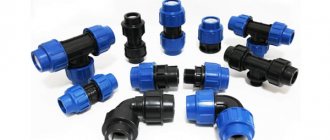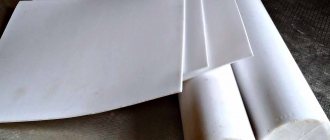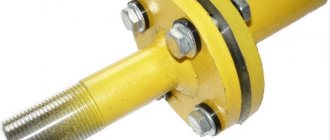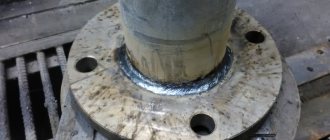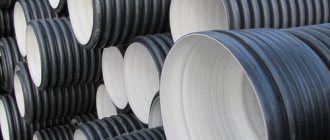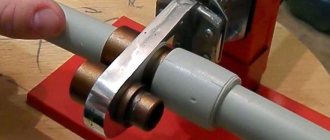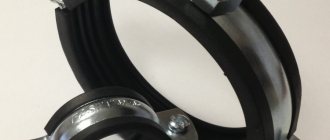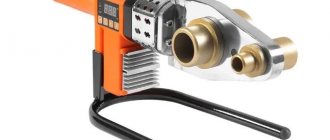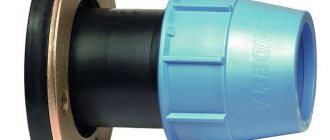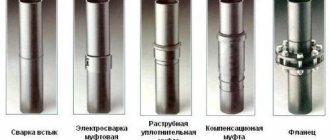Why do polyethylene pipes need steel flanges?
HDPE pipes are certainly superior to steel pipes in the field of cold water pipes, but they have only recently appeared on the market, and metal routes still make up the majority of communications. Polyethylene pipes can be connected to them through permanent PE/steel connections, but sometimes a detachable connection is required. In such cases, steel flanges are used.
Their other area is shut-off and control equipment. Ball valves for HDPE pipes are produced only for small diameters, and for large pipes it is necessary to install metal valves with flanges.
Part Features
The fixing fitting for PE and PVC pipes is a flat disk with equally spaced holes for bolts. This product is installed together with a collar or bushing.
The flange sleeve, which is mounted directly in front of the collar, has an extension for reinforcement. Because of this, the part itself does not fit tightly to the flange.
To eliminate this problem, special bored products are used, in which the internal diameter is increased to the required size, which contributes to the complete tightness of the joint. The remaining parameters of the part are completely similar to standard steel analogues.
Field of application of flanges
Steel products are used quite widely:
- in pressure and non-pressure pipelines;
- in precipitation drainage systems;
- in industrial networks;
- in storm sewer lines.
With the help of flange products, it is possible to achieve the most durable and tight connection of various network elements.
Welding a plastic pipe with a flange sleeve using an electric coupling
If necessary, such a unit can be easily dismantled for repair work or cleaning the system.
Steel pressure flange for PE pipes
Home \ Catalog \ Flanges \ Pressure flange
You may need: HDPE pipe, flange sleeve, flat welded flange, wedge valve, electric welded coupling.
The steel clamping flange for PE pipes is the same flat welded flange, the inner diameter of which is bored to the dimensions required for installation on a PE sleeve. The dimensions of the clamping flange itself and mounting holes correspond to GOST 12820-80. Clamping flanges are produced with a diameter from 20 mm to 1200 mm and a working pressure of PN10 (10 atmospheres) and PN16 , but flanges designed for 6 and 25 atmospheres are also made to order.
Types of steel clamping flanges for PE pipes.
| Standard pressure flange | Powder coated pressure flange | Pressure flange with PP coating |
Application of HDPE clamping flanges
Clamping flanges are used mainly for connecting HDPE pipes to shut-off valves , as well as for connecting PE pipes with pipes and fittings made of cast iron (ductile iron) and steel . Mounting of clamping flanges is carried out using bolts, nuts and studs. The size of fasteners is selected based on the size of the bolt holes of the clamping flanges. To create maximum tightness between the clamping and mating flange, use a rubber or paronite seal (gasket). The use of pressure flanges allows you to create a reliable and tight connection that will last for many years.
Dimensions of clamping flanges for HDPE pipes
| PN = 10 (10 kgf/cm2, 1.0 MPa) | ||||||||
| Outer diameter of HDPE pipe DN, mm | Nominal diameter Dy, mm | Outer diameter D, mm | Diameter of bolt holes D1, mm | Inner diameter D0, mm | Flange thickness b, mm | Number of holes n, pcs | Hole diameter d, mm | Weight, kg |
| 25 | 20 | 105 | 75 | 31 | 12 | 4 | 14 | 0.78 |
| 32 | 25 | 115 | 85 | 42 | 12 | 4 | 14 | 1.05 |
| 40 | 32 | 135 | 100 | 51 | 14 | 4 | 18 | 1.41 |
| 50 | 40 | 145 | 110 | 62 | 15 | 4 | 18 | 1.76 |
| 63 | 50 | 160 | 125 | 78 | 15 | 4 | 18 | 2.02 |
| 75 | 65 | 180 | 145 | 92 | 17 | 4 | 18 | 2.79 |
| 90 | 80 | 195 | 160 | 108 | 17 | 4 | 18 | 3.40 |
| 110 | 100 | 215 | 180 | 128 | 19 | 8 | 18 | 4.03 |
| 125 | 100 | 215 | 180 | 135 | 19 | 8 | 18 | 3.76 |
| 140 | 125 | 245 | 210 | 158 | 21 | 8 | 18 | 5.20 |
| 160 | 150 | 280 | 240 | 178 | 21 | 8 | 22 | 6.86 |
| 180 | 150 | 280 | 240 | 188 | 21 | 8 | 22 | 6.28 |
| 200 | 200 | 335 | 295 | 225 | 21 | 8 | 22 | 9.25 |
| 225 | 200 | 335 | 295 | 238 | 21 | 8 | 22 | 8.28 |
| 250 | 250 | 390 | 350 | 273 | 23 | 12 | 22 | 12.4 |
| 280 | 250 | 390 | 350 | 294 | 23 | 12 | 22 | 10.3 |
| 315 | 300 | 440 | 400 | 338 | 24 | 12 | 22 | 13.6 |
| 355 | 350 | 500 | 460 | 376 | 24 | 16 | 22 | 19.9 |
| 400 | 400 | 565 | 515 | 430 | 26 | 16 | 26 | 25.9 |
| 450 | 500 | 670 | 620 | 517 | 28 | 20 | 26 | 39.4 |
| 500 | 500 | 670 | 620 | 533 | 28 | 20 | 26 | 35.4 |
| 560 | 600 | 780 | 725 | 618 | 31 | 20 | 30 | 51.4 |
| 630 | 600 | 780 | 725 | 645 | 31 | 20 | 30 | 43.0 |
| 710 | 700 | 895 | 840 | 740 | 34 | 24 | 30 | 64.3 |
| 800 | 800 | 1015 | 950 | 843 | 37 | 24 | 33 | 95.8 |
| 900 | 900 | 1115 | 1050 | 947 | 40 | 28 | 33 | 109 |
| 1000 | 1000 | 1230 | 1160 | 1050 | 43 | 28 | 36 | 143 |
| 1200 | 1200 | 1455 | 1380 | 1260 | 51 | 32 | 39 | 201 |
| PN = 16 (16 kgf/cm2, 1.6 MPa) | ||||||||
| Outer diameter of HDPE pipe DN, mm | Nominal diameter Dy, mm | Outer diameter D, mm | Diameter of bolt holes D1, mm | Inner diameter D0, mm | Flange thickness b, mm | Number of holes n, pcs | Hole diameter d, mm | Weight, kg |
| 25 | 20 | 105 | 75 | 34 | 14 | 4 | 14 | 0.89 |
| 32 | 25 | 115 | 85 | 42 | 16 | 4 | 14 | 1.18 |
| 40 | 32 | 135 | 100 | 51 | 16 | 4 | 18 | 1.59 |
| 50 | 40 | 145 | 110 | 62 | 17 | 4 | 18 | 1.96 |
| 63 | 50 | 160 | 125 | 78 | 19 | 4 | 18 | 2.25 |
| 75 | 65 | 180 | 145 | 92 | 21 | 4 | 18 | 3.07 |
| 90 | 80 | 195 | 160 | 108 | 21 | 4 | 18 | 3.71 |
| 110 | 100 | 215 | 180 | 128 | 23 | 8 | 18 | 4.37 |
| 125 | 100 | 215 | 180 | 135 | 23 | 8 | 18 | 4.07 |
| 140 | 125 | 245 | 210 | 158 | 25 | 8 | 18 | 5.6 |
| 160 | 150 | 280 | 240 | 178 | 25 | 8 | 22 | 7.39 |
| 180 | 150 | 280 | 240 | 188 | 25 | 8 | 22 | 6.76 |
| 200 | 200 | 335 | 295 | 225 | 27 | 12 | 22 | 9.63 |
| 225 | 200 | 335 | 295 | 238 | 27 | 12 | 22 | 8.59 |
| 250 | 250 | 405 | 355 | 273 | 28 | 12 | 26 | 15 |
| 280 | 250 | 405 | 355 | 294 | 28 | 12 | 26 | 12.8 |
| 315 | 300 | 460 | 410 | 338 | 28 | 12 | 26 | 17.6 |
| 355 | 350 | 520 | 470 | 376 | 30 | 16 | 26 | 24.8 |
| 400 | 400 | 580 | 525 | 430 | 34 | 16 | 30 | 30.4 |
| 450 | 500 | 710 | 650 | 517 | 44 | 20 | 33 | 55.7 |
| 500 | 500 | 710 | 650 | 533 | 44 | 20 | 33 | 51.3 |
| 560 | 600 | 840 | 770 | 618 | 45 | 20 | 36 | 77.1 |
| 630 | 600 | 840 | 770 | 645 | 45 | 20 | 36 | 58.2 |
You can buy and find out the price of clamping flanges for HDPE pipes from the ALFAVODOSTROY company. Our company’s specialists are ready to advise you by phone +7 (812) 326-05-72 or by email: [email protected] .
Types of HDPE pipe connections
There are several types of connections for polyethylene pipes:
- detachable (on fittings or couplings);
- one-piece - by welding: using a special welding machine;
- electric couplings - a heater is built into such couplings; when electric current is applied to it, the polyethylene heats up and fuses.
They mainly weld large-diameter pipes, which are used to create main pipelines. Pipes of small diameters - up to 110 mm, used in private construction, are mostly connected using fittings. Couplings are used more often during repair work, since their installation takes longer.
READ ALSO: How to Check PP Pipes for Leaks
Fittings for polyethylene pipes are shaped parts (tees, crosses, angles, adapters, couplings) with the help of which the required system configuration is created. Since independent connection of polyethylene pipes is carried out more often with the help of fittings, let’s talk about them in more detail.
Types of products
The main parameters by which flange products for PE and PVC pipes are characterized are the internal diameter, external dimensions, weight and operating pressure.
Depending on what tasks these parts perform, there are the following types of adapters:
- adapter with special welded bushings;
- slip-on metal flange;
- free-type flange adapter supported by a straight or tapered collar.
The best way to connect light and medium PE pipes with a diameter of no more than 150 mm and light pipes with a diameter of up to 300 mm is a loose flange supported by a straight collar. A loose flange with a tapered collar is used for fittings with a diameter of more than 200 mm.
Characteristics of the fixing flange for polyethylene pipes (video)
Advantages and disadvantages of a flange for PE and PVC pipes
The clamping steel loose flange adapter has several advantages over other parts, which makes it more popular to use. The main advantages of the fitting are as follows:
- The adapter allows you to install PE and PVC reinforcement elements into a metal pipeline, which also makes the repair of such systems more affordable.
- To install the flange, there is no need to use any special tools or spend a lot of time: a wrench and a little skill allow you to install the part without any problems.
- Also, the clamping flange adapter has the ability to compensate for the process of compression and expansion of the axis, and this allows for easier installation and operation, and reduces installation time.
As for the disadvantages, the most significant is the fact that the gasket that ensures a tight fit is destroyed. This occurs due to the fact that they are clamped as tightly as possible, and this leads to exceeding the tensile strength of the material.
Flange connection is the most reliable type of pipeline installation
Structurally, the flat clamping adapter is most unsuccessful in this regard, since it cannot protect the gasket from deformation.
Those product models in which gaskets are provided in some recesses are considered more protected from gasket rupture, however, they do not provide full protection, especially with a long service life of the part.
When installing a flange, take into account the fact that metal can expand when exposed to heat. This causes the fastener elements to elongate more than the adapter itself, which can compromise the seal of the flange connection.
Technology for connecting plastic pipes to metal ones
Using Threaded Fittings
To install polypropylene pipes with metal parts (pipes, mixers, meters, filters, etc.), fittings with a thread of the required diameter on one side and a coupling for soldering a plastic pipe on the other are used. The thread on such fittings can be either internal or external.
Connecting steel and polypropylene pipes using fittings:
- Unscrew the coupling of the steel pipe where you intend to connect it to the plastic pipe, or cut off part of the old metal pipe, lubricate the edge with grease or oil and cut a new thread with a thread cutter.
- Wipe the threads, wrap tow (or fum tape), and lubricate with silicone. Make no more than one or two turns so that the edge of the tape, when clamped, is directed along the thread.
- Screw on the pressfitting without using a wrench to avoid cracking. If necessary (if water flows after turning it on), tighten the fitting.
Using polypropylene fittings of various configurations, it is very convenient to make various kinds of bends and turns in the installed pipeline system. It is also possible to change the configuration of the fitting by heating it with a hair dryer, but not more than 140 degrees. It should be remembered that polypropylene ignites when heated above 350 degrees, and you should not allow it to overheat.
Polypropylene pipes have the ability to expand and contract at different temperatures. Therefore, when using them for heating or for supplying hot water, when installing pipes in the wall under a layer of plaster, you should leave a gap in the grooves of at least 1 cm using tubular insulation, especially around the contours and tees.
